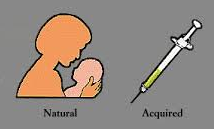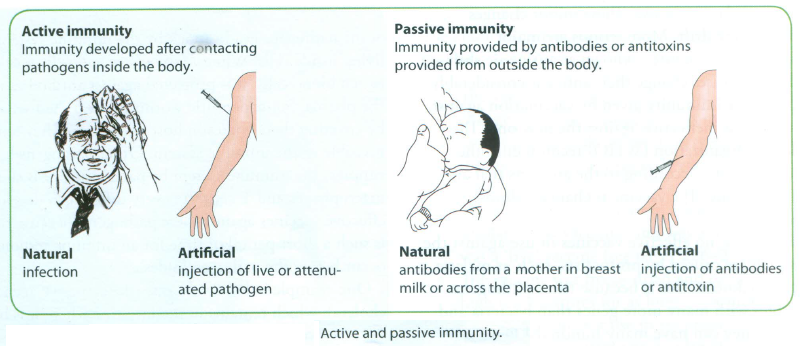Biology
 A person is immune to a disease if the pathogen that causes the disease is unable to reproduce in the body and cause illness. This happens when the body already contains, or is able rapidly to make, large quantities of antibodies against the antigens associated with the pathogen.
A person is immune to a disease if the pathogen that causes the disease is unable to reproduce in the body and cause illness. This happens when the body already contains, or is able rapidly to make, large quantities of antibodies against the antigens associated with the pathogen.
Immunity

Active immunity occurs when the person's own lymphocytes make the antibody. This could be natural, as a result of the person having previously had the disease and forming B or T memory cells. It could also be artificial, as a result of vaccination. This involves introducing weakened pathogens into the body. The lymphocytes react to the antigens on the pathogens by producing antibodies and memory cells.
Passive immunity occurs when antibodies from elsewhere are introduced into the body. In a young baby this can be natural, as the baby acquires antibodies from its mother in breast milk. It can also be artificial, as the result of an injection of antibodies obtained from another animal.
Active immunity lasts much longer than passive immunity, because memory cells last a long time, whereas individual antibodies do not. Injections of antibodies, however, can be useful if a person requires instant immunity, for example if an aid worker is about to travel to an environment where risk of a disease such as hepatitis is high.
Vaccine
A vaccine contains a killed or weakened part of a germ that is responsible for infection. Because the germ has been killed or weakened before it is used to make the vaccine, it can not make the person sick.
When a person receives a vaccine, the body reacts by making protective substances called "antibodies". The antibodies are the body's defenders because they help to kill off the germs that enter the body.
In other words, vaccines expose people safely to germs, so that they can become protected from a disease but not come down with the disease.
Global eradication of infectious disease
The world Health Organization has helped to organise world-wide campaigns to eliminate the serious infectious diseases smallpox and poliomyelitis. Smallpox has been successfully eradicated by vaccinating large numbers of children with weakened viruses similar to those that cause smallpox. This succeeded because the vaccine is highly effective. The programme involved the vaccination of all relatives and contacts of anyone who had the disease, called ring vaccination. The virus did not mutate, so the same vaccine could be used everywhere.
Diseases that have not been successfully eradicated include:
? Measles. This is partly because several successive doses of vaccine are required to produce immunity, especially in children who have weak immune systems because of poor diet or living conditions. The virus is very infective, so a very high percentage of people must be vaccinated to ensure a population is free of it. Booster vaccinations are also needed. This is difficult to achieve in places where infrastructure is poor.
? TB. The BCG vaccination gives only partial immunity, although new vaccines are now being developed which it is hoped will be more effective. TB is difficult to treat because the bacteria live inside body cells. Many strains have developed resistance to antibiotics.
? Malaria. No effective vaccine has yet been developed against Plasmodium. This is a eukaryotic organism, not a bacterium or virus, and is not affected by antibodies produced by B-lymphocytes or by T-lymphocytes.
? Cholera. This disease is caused by the bacterium Vibrio choterae. In the body, it lives and reproduces in the intestine, which is outside the body tissues and not easily reachable by lymphocytes or antibodies. Current cholera vaccines are ineffective, partly because injected vaccines do not readily reach the intestines. Oral vaccines are being developed, which are proving more effective.
Vaccines are, of course, completely ineffective against any diseases that are not caused by pathogens, such as sickle cell anaemia.
- # 63 Summary Of Immunity
1 Phagocytes and lymphocytes are the cells of the immune system. 2 The diagram shows how to recognise phagocytes and lymphocytes in microscope slides and photomicrographs of blood. 3 Phagocytes originate in the bone marrow and are produced there throughout...
- #57 Immunity - Syllabus 2015
? The immune system ? Vaccination Candidates should be able to: (a) [PA] recognise phagocytes and lymphocytes under the light microscope; (b) state the origin and describe the mode of action of phagocytes (macrophages and neutrophils); (c) describe...
- #55 Infectious Diseases And Antibiotics
An infectious disease is one that can be passed between one person and another. Infectious diseases are caused by pathogens. These are usually microorganisms such as viruses, bacteria, fungi or protoctists. A non-infectious disease cannot be passed between...
- # 54.2 Infectious Disease - Syllabus 2016
10.1 Infectious diseases 10.2 Antibiotics The infectious diseases studied in this section are caused by pathogens that are transmitted from one human host to another. Some, like Plasmodium that causes malaria, are transmitted...
- Immunity And Immune System
IMMUNE SYSTEM It is the system that gives immunity to the body by recognizing, responding and remembering foreign antigens. It plays role in allergic reaction, auto-immune disease and organ transplantation. It includes lymphoid organs, tissues, cells...
Biology
# 62 Immunity and vaccination

Immunity

Passive immunity occurs when antibodies from elsewhere are introduced into the body. In a young baby this can be natural, as the baby acquires antibodies from its mother in breast milk. It can also be artificial, as the result of an injection of antibodies obtained from another animal.
Active immunity lasts much longer than passive immunity, because memory cells last a long time, whereas individual antibodies do not. Injections of antibodies, however, can be useful if a person requires instant immunity, for example if an aid worker is about to travel to an environment where risk of a disease such as hepatitis is high.
Vaccine
A vaccine contains a killed or weakened part of a germ that is responsible for infection. Because the germ has been killed or weakened before it is used to make the vaccine, it can not make the person sick.
When a person receives a vaccine, the body reacts by making protective substances called "antibodies". The antibodies are the body's defenders because they help to kill off the germs that enter the body.
In other words, vaccines expose people safely to germs, so that they can become protected from a disease but not come down with the disease.
Global eradication of infectious disease
The world Health Organization has helped to organise world-wide campaigns to eliminate the serious infectious diseases smallpox and poliomyelitis. Smallpox has been successfully eradicated by vaccinating large numbers of children with weakened viruses similar to those that cause smallpox. This succeeded because the vaccine is highly effective. The programme involved the vaccination of all relatives and contacts of anyone who had the disease, called ring vaccination. The virus did not mutate, so the same vaccine could be used everywhere.
Diseases that have not been successfully eradicated include:
? Measles. This is partly because several successive doses of vaccine are required to produce immunity, especially in children who have weak immune systems because of poor diet or living conditions. The virus is very infective, so a very high percentage of people must be vaccinated to ensure a population is free of it. Booster vaccinations are also needed. This is difficult to achieve in places where infrastructure is poor.
? TB. The BCG vaccination gives only partial immunity, although new vaccines are now being developed which it is hoped will be more effective. TB is difficult to treat because the bacteria live inside body cells. Many strains have developed resistance to antibiotics.
? Malaria. No effective vaccine has yet been developed against Plasmodium. This is a eukaryotic organism, not a bacterium or virus, and is not affected by antibodies produced by B-lymphocytes or by T-lymphocytes.
? Cholera. This disease is caused by the bacterium Vibrio choterae. In the body, it lives and reproduces in the intestine, which is outside the body tissues and not easily reachable by lymphocytes or antibodies. Current cholera vaccines are ineffective, partly because injected vaccines do not readily reach the intestines. Oral vaccines are being developed, which are proving more effective.
Vaccines are, of course, completely ineffective against any diseases that are not caused by pathogens, such as sickle cell anaemia.
Syllabus 2015 ? Vaccination (g) distinguish between active and passive, natural and artificial immunity and explain how vaccination can control disease ; (h) discuss the reasons why vaccination programmes have eradicated smallpox but not measles, tuberculosis (TB), malaria or cholera; |
Syllabus 2016 11.2 Antibodies and vaccination Active and passive immunisations are effective ways to treat and prevent infectious diseases. Smallpox has been eradicated; other diseases may soon follow, but vaccine development has proved more difficult for diseases such as malaria. a) relate the molecular structure of antibodies to their functions (see 2.3b) b) outline the hybridoma method for the production of monoclonal antibodies c) outline the use of monoclonal antibodies in the diagnosis of disease and in the treatment of disease d) distinguish between active and passive, natural and artificial immunity and explain how vaccination can control disease e) discuss the reasons why vaccination programmes have eradicated smallpox, but not measles, tuberculosis (TB), malaria or cholera |
- # 63 Summary Of Immunity
1 Phagocytes and lymphocytes are the cells of the immune system. 2 The diagram shows how to recognise phagocytes and lymphocytes in microscope slides and photomicrographs of blood. 3 Phagocytes originate in the bone marrow and are produced there throughout...
- #57 Immunity - Syllabus 2015
? The immune system ? Vaccination Candidates should be able to: (a) [PA] recognise phagocytes and lymphocytes under the light microscope; (b) state the origin and describe the mode of action of phagocytes (macrophages and neutrophils); (c) describe...
- #55 Infectious Diseases And Antibiotics
An infectious disease is one that can be passed between one person and another. Infectious diseases are caused by pathogens. These are usually microorganisms such as viruses, bacteria, fungi or protoctists. A non-infectious disease cannot be passed between...
- # 54.2 Infectious Disease - Syllabus 2016
10.1 Infectious diseases 10.2 Antibiotics The infectious diseases studied in this section are caused by pathogens that are transmitted from one human host to another. Some, like Plasmodium that causes malaria, are transmitted...
- Immunity And Immune System
IMMUNE SYSTEM It is the system that gives immunity to the body by recognizing, responding and remembering foreign antigens. It plays role in allergic reaction, auto-immune disease and organ transplantation. It includes lymphoid organs, tissues, cells...
